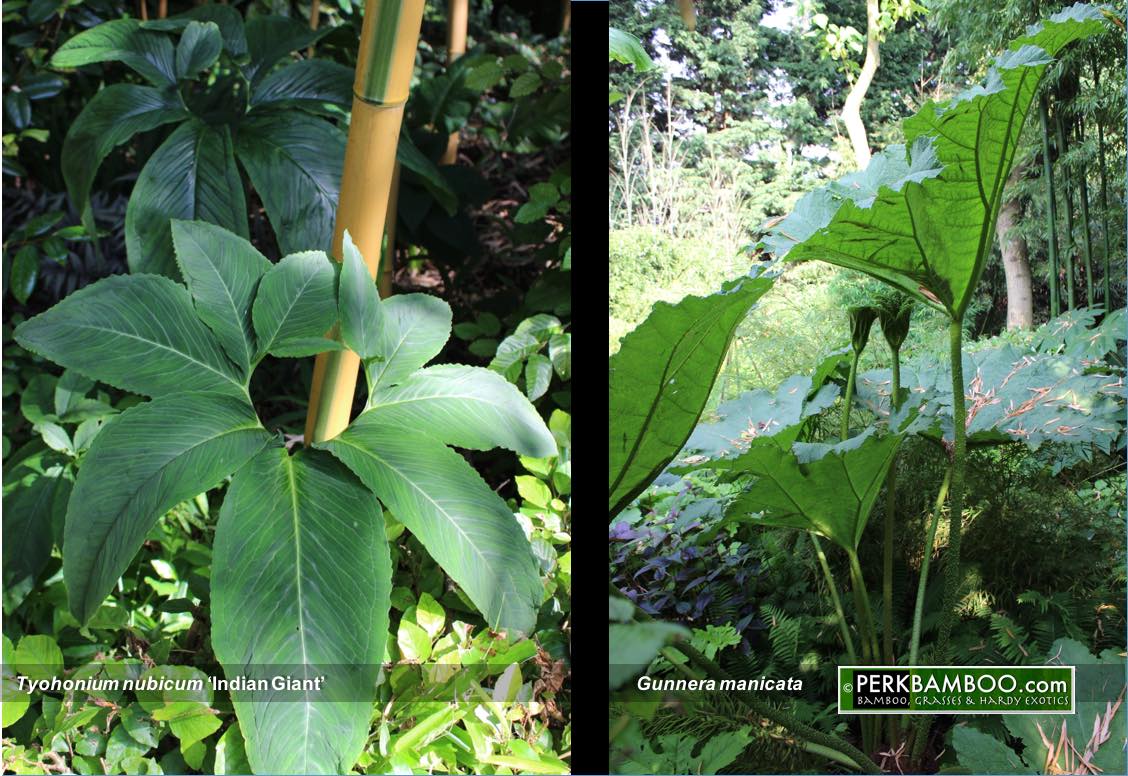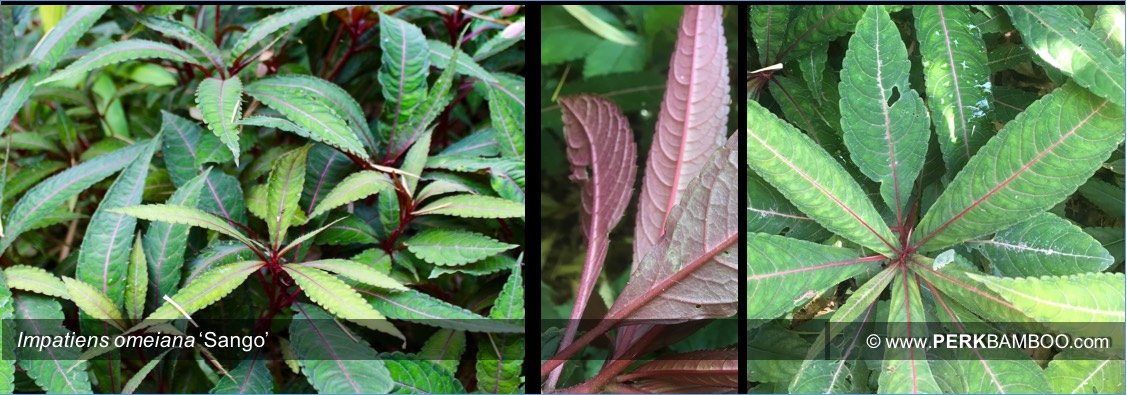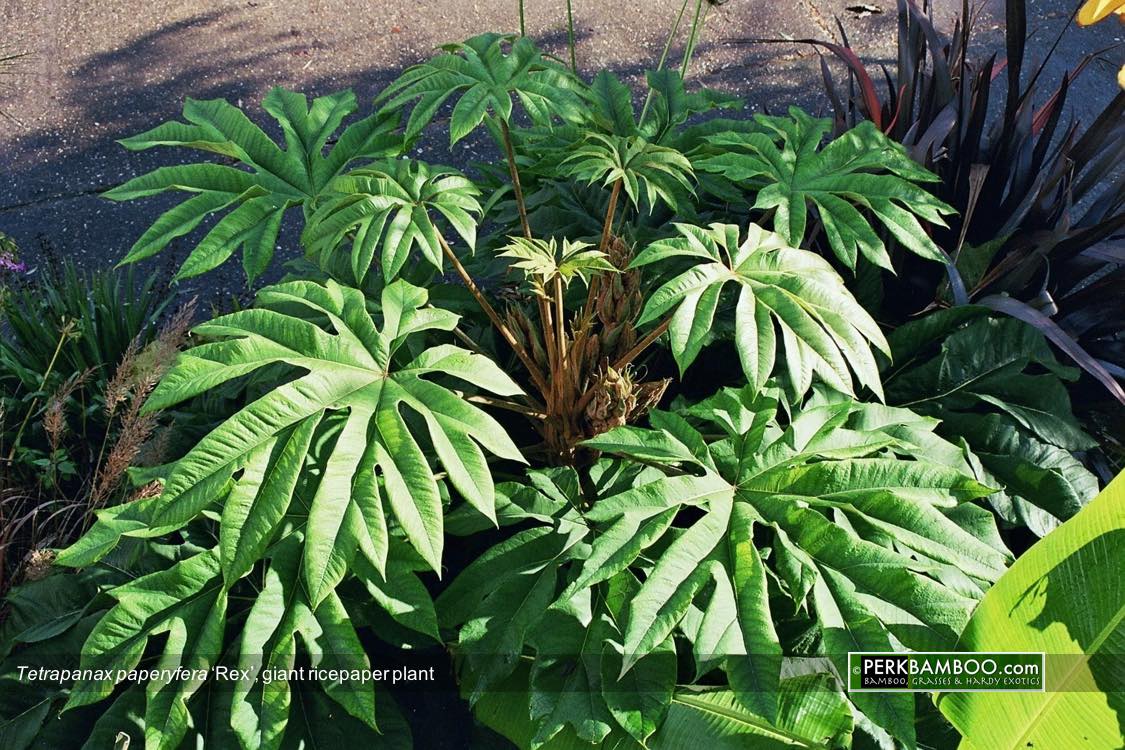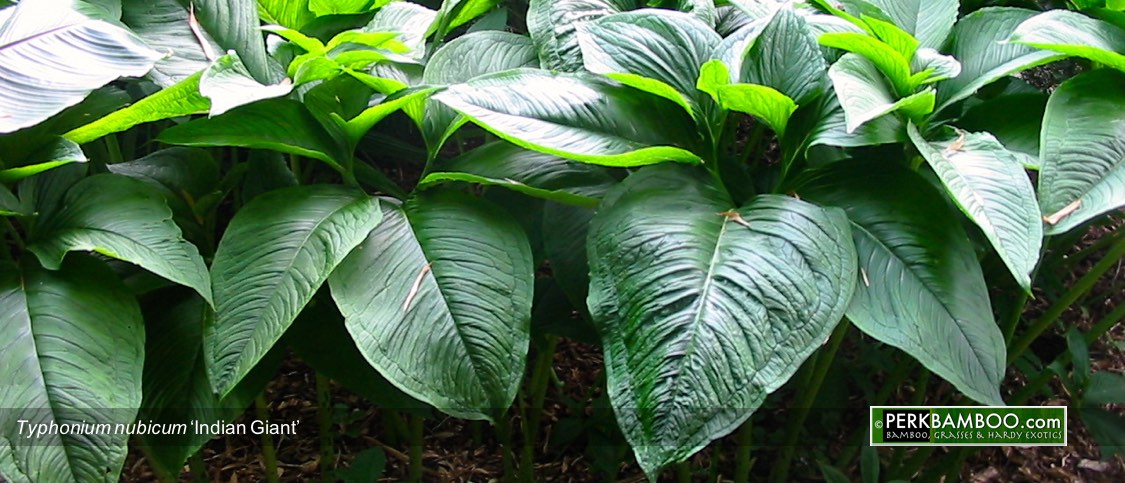BOLD LEAF PLANTS
Arisaema speciosum ‘Magnificum' (China, India) is one of my favorite Cobra Lily species (all deciduous). Striking is the red border around the large, three-lobed leaf. The dark red cup with black winding spadex blooms in spring. The decorative leaves remain until late autumn. This plant prefers a sheltered place in the semi-or dappled shade.
Arisaema ciliatum var. liubaense is a striking appearance in the garden and grows upto 50-90 cm tall. Its leaves grow in an elegant umbrella formation. The purple inflorescence is high on the stem. Grows best in partial shade in humus rich, sufficiently drained soil. The area of origin is located in Western China in deciduous forests at an altitude of 2500 to 3300.
Sometimes we have other species in stock: Arisaema costatum (looks like ‘Magnificum’, but smaller), Arisaema thunbergii sp. Urashima, A. nepenthoides, A. concinnum ‘Tortuosum’.
Arisarum proboscideum (mice tail, Mediterranean) is a small Aroids relative. The end of the flower looks like the tail of a mouse who tries to hide in the green! The flower itself has a chestnut brown color and is at the base usually white. Arisarum proboscideum blooms in the period April-May. The height of is approximately 15-25 cm and prefers a half shaded place in humus-rich soil. The plant can spread slowly because Arisarum proboscideum has a creeping rhizome.
Dracunculus vulgaris, the dragon's tongue lily, is an almost unearthlyplant. This plant grows upto 1.50 to 2 meters, early anticipation with beautiful speckled shoots, large white dotted leaves and as icing on the cake a huge velvet red flower as, indeed, the tongue of a dragon. The black spadex spreads a sickly air attracting flies and beetles for pollination, resulting in a large orange-red fruit in the late summer.
Astilboides tabularis (Shield Leaf) is a majestic foliage plant with a special bright green leaf color for a growing place in the (partial) shade. The large circular leaves have a curved serrated edge. The leaf achieves under optimal conditions, 40 to 70 cm in diameter and is supported in the middle by a hairy petiole. This species bears in the summer pendulous clusters of fragrant creamy white flowers. This clumping deciduous plant combines well with fine-leaved bamboo and ornamental grasses.

Begonia grandis 'Evansii' is a deciduous hardy begonia from China, adding beautiful foliage and striking pink and white flower clusters to the garden. It is a low, bushy plant with striking red stems 40-60 cm tall. The broad, fleshy leaves are light green at the top and copper red on the bottom. During summer and fall ‘Evansiana’ produces fragrant pink flowers in nodding clusters. This begonia prefers a well-drained, humus-rich soil.
Begonia grandis 'Alba' has the same appearance as ‘Evansii, but carries white flowers.
Begonia 'Silver Splendor’ is a new hybrid from hemsleyana (Yunnan, China) with a serrated shape silvery colored leaf. Has been growing in our gardens since 2014.
Begonia luxurians is perhaps the most beautiful species to plant out during summer, but should be overwintered frost free.
Brunnera macrophylla 'Jack Frost’ Silver-Caucasian forget-me-not has beautiful deciduous silver leaves with fine veins. The silver color is displayed throughout the season. During April-May it flowers with light blue flowers. The height is about 30-40 cm. In partial shade, the leaves are the largest. Other new cultivars like Brunnera ‘Sea Heart’ could be improvements.
Colocasia (Elephant Ear) are spectacular deciduous foliage plants from Asia. Colocasia is often confused with the much less cold-resistant Alocasia. When purchasing a Colocasia it is important to ensure that the plants are not from tissue culture (in vitro from laboratory) because these plants lack a woody tuber and will not survive winter. Hand-propagated plants are therefore preferred. Colocasia starts to grow in late spring or early summer and prefers a warm, moist soil. In winter the plant is covered with a thick layer of leaves or compost.
Colocasia hyrid 'Pink China’ seems to be the most vigorous and hardy species for our climate. This plant grows upto 100-150 cm. The green leaves are carried on red-pinkish stalks.
Sometimes there are also other species available like Colocasia esculenta 'Black Magic', a cultivar with purple black leaves. The selection Colocasia antiquorum 'Illustris' is characterized by narrower leaves, a green petiole and a velvety purple leaf.
Colocasia fontanesii 'Black Stem' is a big variety with large, shiny deep green leaves with black ribbing on black leafstalk.

Darmera peltata (Umbrella leaf) is a frost-resistant deciduous plant with large round leaves. This leaf form is rare and is mainly found in not hardy plants like Lotus. The plant has scaly, creeping rhizomes that are half above the ground, reminiscent a prehistoric reptile. The inflorescence appears in early spring, and in good soil reaches a height over 1 meter. The stem is at the top covered with bright pink flowers.

Fatsia japonica (Japanese Aralia) is one of the very few evergreen, exotic-looking foliage plants for (preferable) a sheltered, shaded habitat. The large graceful lobed leaves fall like roof tiles over each other giving the plant a stylistic, architectural appearance. Fatsia grows well on the north side of a house, under the crown of a large tree or in the undergrowth of a tall bamboo. Under favorable conditions Fatsia can grow to a size of 1.5 to 2 meters, but usually remains a compact plant. The inflorescence consists of a bunch of white "balls" with numerous small white or cream-colored sweet flowers. Fatsia flowers in late autumn to early December. The following cultivars are usually available:
Fatsia japonica 'Variegata' (a form with large, creamy white patches on the leaves).
Fatsia japonica 'Spiders Web’ has a white marbled leaf texture which fades more to greens in winter.
Fatsia japonica ‘Moserii’ is a strong green leaved cultivar.
Fatsia japonica 'Murakumo Nishiki' is the rarest and for me most beautiful cultivar with lime to dark green leaf texture patterns.
Sometimes, hydrides Hedera x Fatsia are also available under the name Fatshedera lizei.
Gunnera manicata (giant rhubarb) is the largest of all Gunnera species. This South American mountain plant can grow about 3 to 4 meters in height under favorable conditions with leaves up to 2 meters in diameter. A warm, sheltered spot and permanent access to sufficient moisture and nutrition is preferred. Besides the giant leaves, the flower cones are also impressive. The real Gunnera manicata is rare to find and therefore only limited available by pre-order; plants in trade with the label name ‘manicata’ offered through regular garden centers and webshops etc. are actually the smaller Gunnera tinctoria.

Impatiens omeiana is a beautiful deciduous plant from Sichuan, China with velvet green leaf rosettes with clear veins. Makes side shoots allowing to form a dense foliage in partial shade on a moist soil. Grows upto about 20 to 35 cm high. Very nice as undergrowth or in a group. Some other forms of Impatiens can also be found in the showgarden. A lager, more maroon colored form is in observation in our garden.

Kirengeshoma palmata (Japanese wax flower) has maple-like leafs. Kirengeshoma grows well in dark places. There are two deciduous species known which mutually differ only minimally. The Korean wax flower Kirengeshoma koreana, grows slightly more robust (80 cm) than its Japanese counterpart (70 cm). The inflorescence consists of hanging, soft yellow bells in the period August - September.
Ligularia is an Asian genus of deciduous foliage plants with varying leaf shape from round, serrated to deeply incised decorative. Ligularia’s are decorative plants on a moist soil in sun or (half) shadow. Especially the red leaved cultivars are interesting. Usually there are some types available at the nursery such as hybrids Ligularia stenocephala x przewalskii. Ligularia dentata 'Desdemona', 'Othello' and 'Britt Marie Crawford'.
Nabalus alba (rattlesnake root) is an unknown foliage plant from the US with deeply incised and serrated leaves, a bit like Papaya. This deciduous species rapidly forms a big bunch of leaves, the size of a pizza plate. The inflorescence is 150 cm high and consists of numerous white flowers. Nabalus is clumping and fully hardy. It is easily growing to a humus-rich, somewhat moist soil. Beautiful in combination with fine-leaved grasses, ferns and bamboo.

Persicaria microcephala 'Red Dragon’, Chinese Red Dragon knotweed is a great asset within the knotweed group. This deciduous clumping plant is particularly useful as border filler between higher plants, especially because of the color contrasts. The leaf has a tapered form and has a very nice color with different shades of crimson, russet, crimson and dark green. The stem segments are carmine color. The inflorescence, in late summer, consists of fine clouds of white flowers. 'Red Dragon' delivers beautiful combinations with eg. yellow-leaved plants (like ornamental grass Hakenochloa macra Aureola) and yellow culmned bamboos.
Other selections from microcephala are the silver-red-leaved form Persicaria microcephala 'Silver Dragon', the large-leaved form with a deeper purple leaf texture 'Night Dragon', the small-leaved form with more bright red leaves 'Dragon's Eye', and the smallest species is Persicaria nepalensis .
Persicaria microcephala ‘Oriental Dragon’ is a new form. The leaf is symmetrical lobed and tapered. It has a very nice color with various shades of deep red and dark green. The stem segments are carmine color. The inflorescence, in late summer, consists of fine clouds of white flowers. Forms easier side shoots, so best to contain in smaller gardens.
Persicaria (Tiarella) filiformis has green leaves and gossamer, coral red flowers. The selection Persicaria 'Lance Corporal' has a sun-proof leaf pattern and appears to be growing stronger. A very nice combination plant for fine detail. The form Persicaria ‘Painters Pallet’ is special cultivar with multiple leaf texture colors.

Petasites frigidus var. palmatus 'Golden Palms' is new and striking deciduous foliage plant from the U.S. with initial yellow-green serrated leaves which later in the summer turn to light green upto 30-40 cm high. Grow for several years in the undergrowth of a giant bamboo grove in our garden.
Podophyllum is a group of deciduous foliage plants from forest areas in East Asia. For the garden interesting species and hybrids are Podophyllum hexandrum, ‘Kaleidoscope’ and ‘Spotty Dotty’. The last two have a psychedelic leaf texture. 40-60cm high.
Pollia japonica from Japan is very interesting deciduous rhizomatous perennial growing on upright stems (30-50cm). Features large, oblong to oblanceolate leaves, symmetrical arranged. Appears ginger-like. Prefers dappled shade on an organic soil in our garden. I have never observed any flowering. Rare, sometimes available for sale.
Polygonum orientale, oriental knotweed grows upto 1.5 to 2.5 meters in favorable locations and never gets in the way because the stem bears only at the top branches and flowers. This is an annual plant, which modestly resows itself. Sometimes available from June.
Rheum palmatum ‘Tanguticum' (Russian rhubarb) is an impressive deciduous foliage plant from Russia with deeply incised leaves. Rheum grows best in full sun or partial shade with sufficient water and food.
Rheum palmatum ‘Atrosanguineum' has bright red leaves which turn to dark red and finally green.
Rheum palmatum 'Red Herald’ also has new red leaves but wears red flowers on an elongated peduncle.
Rheum officinalis is a spectacular botanical species of rhubarb Bhutan. The big emerald green leaves are less deep cutted compared with Rheum palmatum. The young leaves in the spring color deep bronze. It is the first foliage plant that comes up in spring. The inflorescence is creamy white. Very hardy. All Rheums are only limited available in large pots.
Rodgersia is an Asian family of majestic forest deciduous plants and consists of a number of interesting species. In the show garden we have planted out several different species. Rodgersia starts later in spring and flowers in white, pink or almost red plumes. There are roughly three types of leaf; oblong-shaped chestnut leaf (aescuifolia), round (pinnata) and serrated / angular (podophylla). Some nice cultivars are 'Mahogany Grey', pinnata 'Superba' and podophylla ‘Rotlaub'. The nursery usually has several selections in stock.
Tetrapanax paperyfera 'Rex' and 'Steroidal Giant’ (Giant Rice paper plant) is perhaps the most impressive deciduous foliage plant I know. A plant with great beauty because of large lobed leaves, architecturally arranged around sturdy trunk. Until mid-90s the barely hardy botanical form Tetrapanax paperyfera was in circulation. Since then, several large-leaved highland forms have been introduced, including the form 'Rex' whose seed was collected by Bleddyn Jones in Taiwan. The form ‘Steroidal Giant’ is derived from a gardener from Japan, imported to the U.S. by a collector and has finally reached Europe. We grow (in small numbers) both 'Rex' and 'Steroidal Giant'. Both are suitable for the full sun to (half) shade. 'Steroidal Giant’ has larger and deeper incised compared to 'Rex'. The old plants in our showgarden have already survived many cold winters since 2006, sometimes including the woody parts, sometimes the above ground parts where damaged by frosts but strong recovered from the root system. Young plants can make root suckers but are easy to remove.

Trachystemon orientalis is one of the best newcomers in the deciduous foliage plants. This snail-resistant, ground-covering foliage plant is not picky regarding habitat and grows well in the shade of trees as long as it is not dry. The large, rough leaves quickly compete out weeds. But for the growing season really starts multiple-flowered panicles appear with sky blue flowers in a purple bract.
Typhonium nubicum 'Indian Giant’,Giant Voodoo Lilly is in our collections since 1995 from from North India import. This Typhonium is surprisingly hardy. The heavy root nodules produce each summer after flowering a great number of large, lobed leaves with a diameter of 60-90 cm on a blue-green leaf stalk with little black spots. A must for lovers of leaf structures! This species is still quite scarce and therefore only available in small quantities. Plant on a sunny to partially shaded spot. After successful pollination a large black fruit develops. Nice to combine with bamboos and bananas or as a solitary for a brilliant leaf effect.
The smaller species Sauromatun (Typhonium) venosum also grows over more than 15 years in our garden and is also usually available.

Sometimes other striking foliage plants are in stock in small numbers such as Melianthus major, Polygonum ‘Spectabile’, Dhalia imperalis (tree dalhia) Zantedeschia ‘Crowborough’, Telekia, Inula ‘Sonnenspeer' and Panax.


